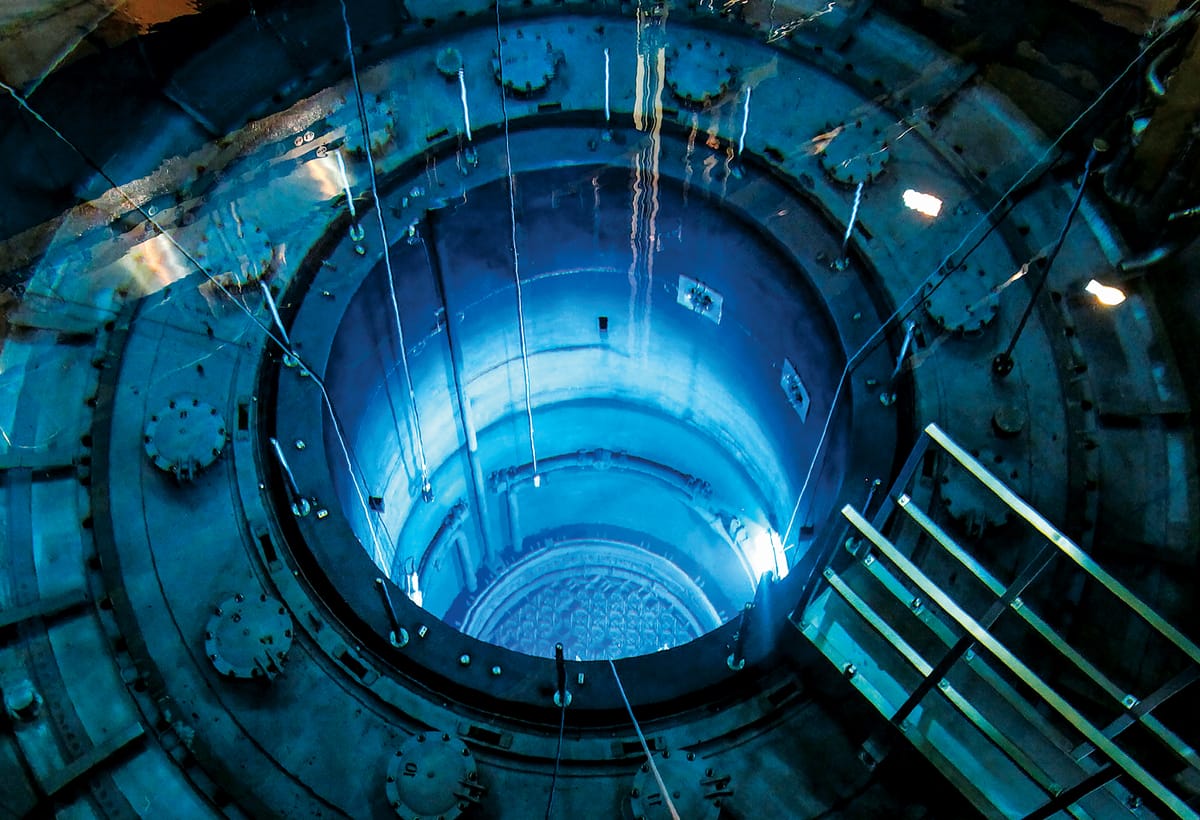Molten Salt Thorium Reactors - The Future of Fission?
Radioactive waste, production of nuclear weapons, the rarity of nuclear fuel. Thorium reactors promise to solve all these problems, and yet why have we not heard of them and how do they work?

According to Google, a single search requires about 0.3 Wh of energy. To put this into context, that is enough energy to power a 60-watt light bulb for 17 seconds. Which seems like an insignificant amount but considering that there are 8.5 billion searches a day (not including the search I just made to look that up) this amounts to 1.05 GWh daily – roughly the daily electricity consumption of over 30,000 American homes. This however number is dwarfed by the average ChatGPT user as every time a user inputs a prompt, ChatGPT’s massive language model processes it, using an estimated 2.9 Wh which is about ten times the energy usage of a standard Google search. With ChatGPT and other AI becoming an increasingly popular tool, it is no wonder that big conglomerates like Microsoft have started to negotiate deals with nuclear power plants to generate energy for their data centres, most notably with the 3 Mile Island reactor being brought back online. Unfortunately, this is sure to cause a stir amongst the anti-nuclear activists with references to nuclear meltdowns and the numerous problems of nuclear waste. If only there were a solution…
In August 2021, China announced the completion of its first experimental thorium molten salt nuclear reactor. Built in the middle of the Gobi Desert in the country’s north, the reactor will undergo testing over the next few years and if the experiment proves successful, Beijing plans to construct another reactor potentially capable of generating electricity for more than 100,000 homes. Thorium offers a promising solution to our energy crisis as many view it as a safer and more efficient way to utilise nuclear energy generating less nuclear waste and it can react at lower pressures, reducing the risk of meltdowns and explosions. It also has benefits that stretch far beyond environmental concerns due to its non-fissile nature, making it not viable for the manufacturing of nuclear weapons, and so will reduce security concerns as.
History

Swedish chemist Jöns Jacob Berzelius discovered Thorium in 1828. It is a silvery white metal, but oxidises and turns grey or black on exposure to air. It is about half as abundant as lead and is three times more abundant than uranium in Earth’s crust which making it an attractive candidate for nuclear energy production. However, its potential as a fuel source did not gain significant attention until the mid-20th century, when the rapid development of nuclear technology opened the door to new possibilities. In the 1950s and 60s, thorium-based reactors emerged as a promising alternative to uranium-based systems. The most notable project was the Molten Salt Reactor Experiment (MSRE) conducted at the Oak Ridge National Laboratory in the United States. This experiment demonstrated the feasibility of using thorium in molten salt reactors, showcasing its potential for enhanced safety and efficiency.
Despite these promising developments, thorium reactors were ultimately sidelined during the cold war when uranium and plutonium-based reactors were favoured for their ability to produce weapon grade material for nuclear warheads. Unlike uranium, thorium does not directly yield isotopes suitable for nuclear weapons thus limiting its appeal during the Cold War. Furthermore, the nascent state of thorium technology faced competition from the already well-established and researched uranium fuel cycle which already had significant industrial and political backing. As a result, thorium reactors remained an intriguing yet underutilized concept, overshadowed by the dominance of uranium and the challenges of transitioning to a new form of nuclear fuel.
The goal with any reactor is to produce thermal energy using nuclear chain reactions. The way this is done varies drastically between reactors, and molten salt reactors are perhaps one of the most unique. Modern reactors currently use solid fuels in their operation, with uranium being the dominant fuel for these. MSRs however dissolve their fuel in a molten salt mixture, allowing for many interesting benefits which will be discussed in the section below. First it is important to understand the reactor's operation.
How they work
Thorium-based nuclear power generation is fuelled primarily by the nuclear fission of the isotope uranium-233 produced from the fertile (opposite of fissile) element, thorium. At their core, these reactors use a liquid mixture of fluoride salts as both the coolant and the medium for dissolving nuclear fuel. Unlike solid fuel rods in conventional reactors, the fuel in MSRs is in a liquid state, allowing for more efficient heat transfer and improved operational flexibility. In thorium salt reactors, thorium-232 acts as the fertile material, which, upon absorbing a neutron, turns into uranium-233 - a fissile isotope that sustains the nuclear reaction. Upon nuclear fission, a neutron is produced by the atom and is absorbed by another atom of thorium which decays into protactinium within half an hour and then back to uranium 233 within a month allowing the fuel cycle to repeat. This fuel cycle is not only efficient but also significantly reduces the production of long-lived radioactive waste. The longest half-life for uranium reactor waste is over 200,000 years while the waste product with the longest half-life for thorium is a mere 30 years.

In addition, one of the most compelling advantages of molten salt reactors is their inherent safety features. Traditional reactors rely on active cooling systems that can fail during power outages, leading to potential overheating and catastrophic failures, as seen in historical incidents like Fukushima. In contrast, MSRs operate with passive safety mechanisms. For instance, they incorporate drain tanks with freeze plugs—devices designed to melt in the event of overheating, allowing the molten fuel to flow into a safe containment area where the reaction halts naturally without the need for human intervention. This feature dramatically reduces the risk of meltdowns and enhances public confidence in the technology.

So what's the fuss all about?
At this point, the so-called “environmentalist” will be running out of things to critique nuclear energy and will inevitably resort to fearmongering stirring up fears that nuclear power plants create nuclear weapons that will blow us all up. Fortunately, nature has thought of everything.
Ironically, the very thing that made Thorium such an undesirable reactor fuel in the Cold War makes it even more ideal for us now. Thorium itself is not fissile, but when used in a molten salt reactor, it breeds uranium-233, which is significantly more difficult to weaponize as the separation process to isolate and enrich it is extremely difficult compared to plutonium-239 or highly enriched uranium-235 as it is often mixed with elements like protactinium. Currently many countries do not have access to nuclear power due to the threat it poses to violating international treaties relating to nuclear proliferation. With more focus on developing thorium reactors, this may reduce fears of nuclear proliferation sufficiently to open the door for the wider adoption of nuclear energy.
We are now left with the question why we are not using this seemingly perfect technology – after all, everything “wrong” with conventional nuclear fissions is solved by Thorium. Though molten salt reactors offer significant advantages such as inherent safety, reduced nuclear waste, the relative abundance of thorium fuel and reduced risk of nuclear proliferation, they face substantial barriers to widespread adoption. The technology is not yet commercially mature, with challenges including materials corrosion of reactor parts which have been in contact with the reactive molten salt coolants, complex fuel cycles, and high initial costs for infrastructure and development. Regulatory frameworks are currently tailored to traditional uranium reactors, creating licensing hurdles for MSRs while the dominance of established uranium-based technologies make it difficult to transition to thorium, as new technologies must be developed to accommodate the new fuel cycles. Although thorium MSRs are considered proliferation-resistant, concerns about uranium 233 production and the need for new international safeguards persist as this isotope is also fissile and can therefore, at least theoretically be weaponised, even if the process is much more expensive and complicated.
But perhaps the largest obstacle in our way are the sceptics. The people telling you that nuclear power is bad and are therefore putting pressure on governments not to have anything to do with it. These people have an unfortunate tendency to immediately think poorly of nuclear power because of events like Chernobyl and 3 Mile Island that they forget that more people have died falling off wind turbines than all the nuclear meltdowns in history. In fact, studies have shown that far fewer people have died from nuclear accidents then any other energy sources. Internationally recognised death statistics show that only 32 people have died as a result of Three Mile Island, Chernobyl and Fukushima, the only major nuclear accidents to have taken place. This results in an overall 90 deaths per 1000TWh. Surprisingly wind power, the next safest energy source has 150 deaths per 1000TWh! The stigma surrounding nuclear power is often blown out of proportion and we have to come to terms with the fact that if we want a reliable, emission free energy source, we may have to go nuclear, and MSR just might be the solution.

Going forward
When we discuss the future of nuclear energy, most people will rave about nuclear fusion. However, we have been hyping nuclear fusion up for decades and yet we still have a long way to go till we finally perfect it. What we need in the interim is a form of energy that is emission free, reliable and efficient. People fear forms of energy that involve fission because of how incredibly powerful it is but this is what our modern society needs – an energy source capable of driving industries that can keep up with our ever-hungry appetite for power and, perhaps most importantly, lifting people out of poverty by providing cheap and clean energy. Thorium has the potential to do all of that without many of the disadvantages associated with uranium. Imagine if a caveman gave up on using fire because he burnt his house down with it. Where would we be now?



